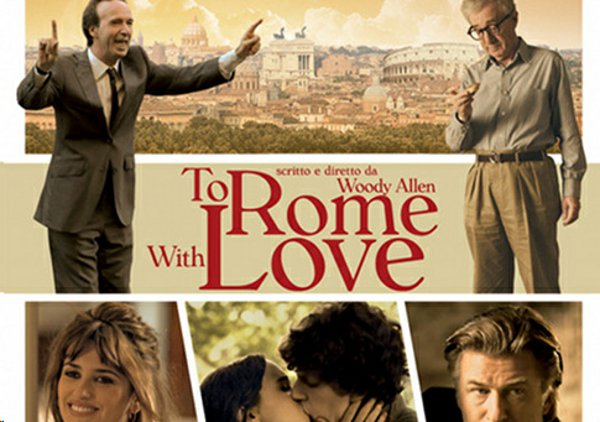Woody Allen Pays Homage to the Eternal City in His Latest Comedy of Errors

Continuing the tradition of films that capture the magic and mystery of the Eternal City, the most famous of which are Federico Fellini’s“Roma” (1972), William Wyler’s “Roman Holiday” (1953) and Roberto Rossellini’s “Rome, Open City” (1945), Woody Allen’s new film, “To Rome with Love,” is his own portrait of the city of Rome. In an ode to the Italian capital as well as to Italian cinema, Allen adopts a structure more similar to that of Fellini in “Roma” with a series of loosely connected episodes. Through these stories, Allen pays homage to the city’s beauty, energy and its knack for absurd situations. He captures the spirit of chaos that Rome is famous for, showing it as the city where nothing goes as planned.
The film opens with the 1950s pop hit “Volare” playing in the background, as a Roman traffic cop stands at the center of Piazza Venezia’s busy intersection, telling us that he can see everything that happens in the city. He then introduces the various characters – foreign and native, young and old – who will be the heroes of the four vignettes of “To Rome with Love,” most of which deal with and are connected by the conflict between desire versus fidelity, and anonymity versus fame.
The vignettes begin with Hayley (Alison Pill, “Midnight in Paris”), an American in Rome, asking directions from a handsome Italian lawyer Michelangelo (Flavio Parenti, “I Am Love”). He offers to walk her to the Trevi fountain. That summer, the two start dating and soon become engaged. Hayley’s parents, Jerry (Woody Allen, in his first on-screen appearance since “Scoop”) and Phyllis (Judy Davis, “Husbands and Wives”) are then on their way to Rome to meet their daughter’s fiancé. Jerry is a retired classical music producer, whose avant-garde productions include staging Rigoletto with all the characters dressed as white mice, and Tosca done entirely in a phone booth. As the American couple dines with their Italian in-laws to be, Jerry overhears Michelangelo’s father, Giancarlo (played by renowned tenor Fabio Armiliato), singing and believes that he has discovered an operatic genius. Over dinner, he tries to convince Giancarlo to become his new opera star. The problem is that Giancarlo loves his job as a mortician, does not want the lifestyle of a star and, perhaps most problematically, can only sing in the shower. But maybe Jerry can come up with a plan.
In another thread, Allen shows a reserved newlywed couple, the uptight Antonio (Alessandro Tiberi) and his sweet wife Milly (Alessandra Mastronardo). They arrive from a small town, check into a Roman hotel and prepare for a very important meeting. They want to impress their extended family in hopes of getting Antonio a job in their business. But when Milly steps out to get a haircut, Anna (Penélope Cruz, “Vicky, Christina, Barcelona”), a sexy call girl, shows up in Antonio’s hotel room and says she’s been paid to provide her services.

As Antonio fights off the escort, who is made to look like Sophia Loren in “Yesterday, Today and Tomorrow,” his aunts and uncles come in, and Antonio feels compelled to introduce Anna as his wife. Meanwhile, Milly finds herself lost in the city, asking the famous actress Ornella Muti for directions, and then on a date with an Italian movie star in the very restaurant where Antonio, his relatives and Anna are to have lunch. Amid the chaos and complications that ensue, adultery seems just around the corner.
Simultaneously, Allen introduces John (Alec Baldwin), a middle-aged architect visiting Rome for a few days. While reminiscing about his days of living in Trastevere as an architecture student, John meets Jack (Jesse Eisenberg, “Social Network”), who in a Scrooge-like twist, seems to be John's younger self. Jack lives in Rome with his girlfriend, Sally (Greta Gerwig, “Damsel in Distress”), in the same apartment that John used to live 30 years prior. When Sally’s best friend, Monica (Ellen Page, “Juno”), a struggling actress, comes to visit, Jack begins to fall for Monica, and John, who is invisible to the rest, urges him on, not unlike Humphrey Bogart in Allen’s 1972 film “Play It Again, Sam.” Here the city provides a romantic backdrop for a new love story to blossom, and Jack struggles with his conflicting desires between staying with a girl he likes and pursuing a fascinating seductress.
In the fourth vignette, Allen caricatures Italians’ passionate fascination with celebrity and fame. He shows a middle-class Italian office clerk Leopoldo (Roberto Benigni, “Life is Beautiful”), a regular family man who walks out of his apartment one day to discover that he has become the best-known celebrity of Italy. To his surprise,
he is approached by paparazzi and talk-show hosts, who explain that he is “famous for being famous,” that is, famous simply because this is what the media decided. (This may be a satire on how media tycoon Silvio Berlusconi came to fame.) As Leopoldo is being asked for autographs and invited on to the red carpet, Benigni uses his character’s bewilderment to give a comic performance. In this episode, Allen explores the fine line between losing one’s freedom and gaining fame.
Absurd situations such as mistaken identities, serendipitous meetings, love triangles and outrageous creative endeavors are at the heart of “To Rome with Love.” It is part satire, part comedy of errors, with some love stories, nostalgia and magical realism mixed in. Through a series of adventures and misadventures, the film shows the modern Rome as belonging to natives and newcomers alike, as it celebrates the city’s captivating landmarks and rich cinematic history.
Author Bio:
Elizabeth Pyjov is a contributing writer at Highbrow Magazine.































































































































































































































































































































